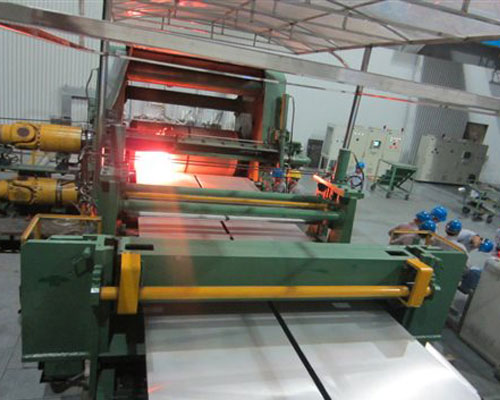The molten metal feed tip for continuous caster is a pair of substantially rectangular refractory members, each having a downstream edge portion and an upstream edge portion, and each member is formed of a refractory fiber mat rigidly bonded together. The refractory fiber is compressed near the downstream edge portion to a greater density than the upstream portion of the member.
A device adjacent to the upstream portion is used to space the pair of members apart to form a metal feeding gap between the members, and to allow molten metal to enter the gap to flow toward the downstream edge portion. Among them, the thermal conductivity of the refractory fiber felt gradually increases from the upstream part to the downstream edge part.
Molten Metal Feed Tip for Continuous Caster
For many years, continuous casting of aluminum has been performed using continuous casting machines in commercial-scale operations. This kind of continuous casting machine includes a pair of rotating water-cooled rollers. For example, the molten aluminum is fed into the nip of the rolls just before the closest line of the two rolls. By contacting the rollers, heat is quickly extracted from the molten metal, and freezing occurs before the metal reaches the line closest to the two rollers. A significant thermal shrinkage of the thickness of the formed aluminum plate occurred between the rollers that recrystallized the aluminum plate.
Using the caster tips can continuously cast aluminum plates several meters wide and about one centimeter thick at a speed greater than one meter per minute for several days. An important aspect of this continuous casting machine is the structure used to feed molten metal into the nip of roll.

Feed Tip Material
A reasonably satisfactory molten metal feed end has been made from an insulating composition that is a composite of asbestos fibers and clay particles. Although this material is easy to form and resistant to molten aluminum, etc., it has obvious disadvantages. One of the most important problems with this material is the presence of asbestos, which is considered carcinogenic.
This is a particular problem for this material used to construct molten metal feed tip for continuous caster, because the material has been processed into the required geometry in practice. Machining produces many particles, which are very dangerous when spread in the air. Expensive dust collection and recycling systems are essential for processing asbestos-containing materials.
The materials currently used for feed tips are also somewhat fragile and have encountered difficulties due to accidental damage. Moisture is very detrimental to the strength of composite asbestos clay materials, and will exacerbate fracture problems. Since the rolls are water-cooled, moisture is usually present near the continuous caster, and sometimes release compounds from the aqueous suspension are applied to the roll surface. In a humid environment, moisture will condense on the roll and contact the molten metal feed head.
Generally, the molten metal feed tip made of the asbestos clay composition can only be run on the continuous casting machine once. In the process of cleaning and repairing in the new operation, the damage of this type of feed head is very common, and this type of feed head must be replaced continuously.
In addition, due to the fragile nature of the material, this feed tip is manufactured to have the largest possible material thickness to maximize the strength near the thin downstream edge of the tip between the rollers. Therefore, the outer surface of the continuous caster feed head usually has a radius closely parallel to the radius of the roller of the parallel caster. This exacerbates the problem of moisture contacting the feed tip, and may also cause oxide chips and other debris to accumulate between the feed tip and the roller. Due to the curvature of the surface of the feed tip, the presence of such debris is not easily detected and may cause defects in the sheet formed by the continuous casting machine.
For similar reasons, the inner surface of the feed tip for continuous caster is formed with parallel surfaces connected by steep slopes. Therefore, the width of the gap between the inner surfaces through which the molten metal flows has a relatively rapid change in cross-sectional area. This leads to rapid changes in the speed of the molten metal, and changes in the shape of the inner surface can provide a place for the temporary accumulation of oxides and other debris, which will spread out intermittently and cause defects in the thin plates produced by the continuous caster.
Therefore, it is desirable to provide a molten metal feed nozzle for a continuous casting machine with improved strength and easy manufacturing. The tip should be free of asbestos to health hazards and relatively insensitive to moisture degradation. It is desirable for the feed head to have a smooth continuous profile to minimize defects in the sheet made by the continuous casting machine and avoid discontinuities in the performance of the feed head. Preferably, the molten metal feed tip should be usable for several runs of the continuous casting machine.

